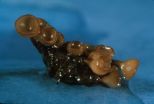(Press-News.org)
VIDEO:
In a few tenths of a second, Sclerotinia expels hundreds of thousands of spores in a plume that can rise 20 cm, much higher than any single spore by itself....
Click here for more information.
Long before geese started flying in chevron formation or cyclists learned the value of drafting, fungi discovered an aerodynamic way to reduce drag on their spores so as to spread them as high and as far as possible.
One fungus, the destructive Sclerotinia sclerotiorum, spews thousands of spores nearly simultaneously to form a plume that reduces drag to nearly zero and even creates a wind that carries many of the spores 20 times farther than a single spore could travel alone, according to a new study by mathematicians and biologists from the University of California, Berkeley, Harvard University and Cornell University.
"In the Tour de France, riders form a peloton that can reduce air drag by 40 percent," said co-lead author Marcus Roper, a postdoctoral researcher in the Department of Mathematics at UC Berkeley and at Lawrence Berkeley National Laboratory. "The ascospores of Sclerotinia do the peloton perfectly, reducing air drag to zero and sculpting a flow of air that carries them even farther."
Presumably, this strategy helps the fungi get their spores off the ground into the foliage of their host plants, or into airstreams that can carry them to host plants, the scientists say.
Co-lead author Agnese Seminara, a postdoctoral researcher and theoretical physicist in Harvard's School of Engineering and Applied Sciences, added: "I realized that the spores behaved much like cloud droplets. To follow their paths, I adapted algorithms I had developed to describe cloud formation."
Roper, Seminara, and colleagues report the findings this week in the early online edition of the journal Proceedings of the National Academy of Sciences (PNAS).
"These findings could have implications for methods of controlling the spread of fungal pathogens," said senior author Anne Pringle, associate professor of organismic and evolutionary biology at Harvard. "Sclerotinia alone costs U.S. farmers on the order of $1 billion annually, including costs of controlling the fungus and crop losses. Research directed at understanding how to disrupt the cooperative ejection of spores may provide novel tools for the control of these fungal pathogens."
Researchers in the field of bioballistics – how plants, fungi and animals accelerate seeds, spores or even parts of their body to high speed – have found an amazing variety of techniques to overcome friction with the air, the main limitation for small spores and seeds.
"Understanding how Sclerotinia is discharging its spores and getting them onto the plants will eventually lead us to new ways of looking at plant architecture," said co-author Helene Dillard, a plant pathologist who heads Cornell University's Cooperative Extension and is associate dean of the College of Agriculture and Life Sciences. "When plant breeders are developing new varieties of crops – such as beans, cabbage or sunflowers – they can keep in mind how Sclerotinia gets the spores to reach their targets, which is usually the flowers."
Scientists have recognized for more than 100 years that many spore-producing fungi – the ascomycetes – release their spores in plumes that carry them long distances. More than 50 years ago, scientists noted that these spore plumes create a wind of their own, but the physics of the plumes was not understood, Roper said. In addition, little work has been done on how seeds or spores cooperate to improve dispersal to new environments.
With training in the mathematics and physics of fluid flow, Roper and Seminara decided to investigate in collaboration with Pringle, a Harvard mycologist.
For the current PNAS paper, the researchers used high-speed video to clock the speed of spores ejected by Sclerotinia, finding that they are expelled at a speed of about 8.4 meters per second (19 miles per hour). However, because the spores are so small – 10 microns long – air drag brings them to a stop in a mere 3 millimeters. When thousands of spores are ejected at the same time, however, some can travel more than 100 millimeters, or 4 inches.
These high-speed video images enabled Roper and Seminara to model spore plume movement precisely with standard equations of hydrodynamics. They showed that the thousands of spores ejected at the same time quickly eliminate all drag and allow the spores to travel about a centimeter, by which time the wind generated by the spores captures and whisks them to a speed of 60 centimeters per second. Their upward motion is stopped only by gravity, Roper said.
The added range from "hydrodynamic cooperation" allows fungi on the ground to shoot their spores into flowers or plant wounds, whence they can quickly spread throughout the plant and kill it.
Often called white mold, Sclerotinia rot, or wilt, the fungus attacks more than 400 species of plants, Dillard said, including beans, sunflowers, soybeans, canola and peanuts, and can wipe out entire fields. In spring and summer, the fungus produces cups (apothecia) about one-half centimeter across that spew spores into the air to infect plants. The fungus produces overwintering seed-like bodies called sclerotia on the infected plant tissues.
"It grows across a cabbage head and produces these small sclerotia that look like mouse droppings," Dillard says. "The sclerotia fall on the ground, and are then in position to initiate the infection process the following year."
The researchers were also curious how fungi manage to eject their spores simultaneously. To investigate this, they grew another mold, a coprophilic fungus from the genus Ascobolus, on horse dung and focused their high-speed video camera on the two-millimeter, cup-shaped fruiting body containing tens of thousands of spore sacs (asci), each containing eight spores. They found that, while the spore sac that ejects first seems to be random, after the first one or two go off, a wave of ejection travels outward as successive rings of spore sacs rupture in sequence. Because this happens in one-tenth of a second, the ejection seems simultaneous.
"What looks like a plume is actually a series of sheets going off," Roper said.
By tweaking their mathematical model to take account of this, Roper and Seminara discovered that cooperative ejection in sheets is a highly effective method for shooting spores long distances. The scientists continue to investigate how spore ejection is initiated, and whether and how spores can cheat to make sure that they get ejected farther than their companions.
INFORMATION:
Other authors of the paper are Mahesh M. Bandi of Harvard and Ann Cobb of Cornell. The work was funded by a Miller Institute for Basic Research in Science Fellowship to Roper, a Marie Curie Fellowship from the European Union Framework 7 to Seminara, and Harvard University.
Fungal spores travel farther by surfing their own wind
Hydrodynamic model of spore plumes explains how plume gives spores an extra oomph
2010-09-28
ELSE PRESS RELEASES FROM THIS DATE:
Insecticides from genetically modified corn present in adjacent streams
2010-09-28
In a paper published this week in the Proceedings of the National Academy of Sciences, Cary Institute aquatic ecologist Dr. Emma Rosi-Marshall and colleagues report that streams throughout the Midwestern Corn Belt are receiving insecticidal proteins that originate from adjacent genetically modified crops. The protein enters streams through runoff and when corn leaves, stalks, and plant parts are washed into stream channels.
Genetically-modified plants are a mainstay of large-scale agriculture in the American Midwest, where corn is a dominant crop. In 2009, more than ...
Scientists arrive in Senegal to give African hunger a black eye
2010-09-28
Burness Communications
Godwin Atser
g.atser@cgiar.org
234-803-443-0027
CGIAR
Scientists arrive in Senegal to give African hunger a black eye
At the World Cowpea Research Conference, crop experts embrace one of agriculture's oldest legumes -- prized for protein and resilience to hot, dry climates -- as food for people, livestock and astronauts
This release is available in French.
DAKAR, SENEGAL (27 September 2010)—A long neglected crop with the potential to halt hunger for millions in Africa, sustain the livestock revolution underway in developing countries, ...
Rewiring a damaged brain
2010-09-28
Researchers in the Midwest are developing microelectronic circuitry to guide the growth of axons in a brain damaged by an exploding bomb, car crash or stroke. The goal is to rewire the brain connectivity and bypass the region damaged by trauma, in order to restore normal behavior and movement.
Pedram Mohseni, a professor of electrical engineering and computer science at Case Western Reserve University, and Randolph J. Nudo, a professor of molecular and integrative physiology at Kansas University Medical Center, believe repeated communications between distant neurons in ...
Baby boomers raise midlife suicide rate
2010-09-28
Baby boomers appear to be driving a dramatic rise in suicide rates among middle-aged people, a new study finds.
The suicide rate for middle-aged people – a group considered relatively protected from suicide and with historically stable suicide rates – took an upward jump between 1999 and 2005, according to research by sociologists Ellen Idler of Emory University and Julie Phillips of Rutgers University.
Their study has been published in the September/October issue of the journal Public Health Reports.
"The findings are disturbing, because they're a reversal of a long-standing ...
GMO research: Report on concrete measures to avoid mixing of GM and conventional maize
2010-09-28
A report presented today by Health and Consumer Policy Commissioner John Dalli to the Agriculture Council concludes that specific measures relating to storing and the application of isolation distances can help limit or avoid the co-mingling of genetically modified (GM) maize with conventional and organic maize. In particular, the Best Practice Document, prepared by the European Coexistence Bureau (ECoB) and published by the European Commission's Joint Research Centre (JRC), notes that storing seeds adequately and applying spatial isolation are the best ways to limit or ...
Homeless youths most often victims of crime: study led by York U researcher
2010-09-28
TORONTO, Sept. 27, 2010 − Homeless young people are victims of crime at rates that society would consider unacceptable for any other group, according to a new report by researchers at York University and the University of Guelph.
The report, Surviving Crime and Violence: Street Youth and Victimization in Toronto, highlights the degree to which it is street youth themselves − often perceived as delinquent and dangerous − who are vulnerable to crime and violence.
"The very people we are taught to fear are the ones who are most at risk," said Professor ...
Study finds brainstorming 'rules' can lead to real-world success in business settings
2010-09-28
Researchers have long held that there are steps that can be taken to make brainstorming sessions more productive. New research from North Carolina State University finds that these recommendations actually do contribute to success when applied in real-world business environments.
"Previous research has laid out best practices that are conducive to brainstorming, or group decision making, and we wanted to see whether using those practices makes a difference in the real world," says Dr. Joe Brazel, associate professor of accounting at NC State and co-author of a paper describing ...
Interaction with neighbors: Neuronal field simulates brain activity
2010-09-28
The appearance of a spot of light on the retina causes sudden activation of millions of neurons in the brain within tenths of milliseconds. At the first cortical processing stage, the primary visual cortex, each neuron thereby receives thousands of inputs from both close neighbors and further distant neurons, and also sends-out an equal amount of output to others.
During the recent decades, individual characteristics of these widespread network connections and the specific transfer characteristics of single neurons have been widely derived. However, a coherent population ...
Rapid test to save Indian vultures from extinction
2010-09-28
Diclofenac, an anti-inflammatory agent, has been deployed successfully in human medicine for decades. In most EU countries medication containing Diclofenac is only approved for treatment of humans. In India, Pakistan and Nepal it has been deployed in veterinary medicine as well since the 90s, in particular for livestock. When vultures feed on cattle carcasses, they too ingest the drug. As a result, the populations of three species of these birds of prey – the Indian vulture, the Oriental white-backed vulture and the slender-billed vulture – have shrunk to a mere three percent ...
Quarks 'swing' to the tones of random numbers
2010-09-28
At the Large Hadron Collider at CERN protons crash into each other at incredibly high energies in order to 'smash' the protons and to study the elementary particles of nature – including quarks. Quarks are found in each proton and are bound together by forces which cause all other known forces of nature to fade. To understand the effects of these strong forces between the quarks is one of the greatest challenges in modern particle physics. New theoretical results from the Niels Bohr Institute show that enormous quantities of random numbers can describe the way in which ...
LAST 30 PRESS RELEASES:
Decoupling the HOR enhancement on PtRu: Dynamically matching interfacial water to reaction coordinates
Sulfur isn’t poisonous when it synergistically acts with phosphine in olefins hydroformylation
URI researchers uncover molecular mechanisms behind speciation in corals
Chitin based carbon aerogel offers a cleaner way to store thermal energy
Tracing hidden sources of nitrate pollution in rapidly changing rural urban landscapes
Viruses on plastic pollution may quietly accelerate the spread of antibiotic resistance
Three UH Rainbow Babies & Children’s faculty elected to prestigious American Pediatric Society
Tunnel resilience models unveiled to aid post-earthquake recovery
Satellite communication systems: the future of 5G/6G connectivity
Space computing power networks: a new frontier for satellite technologies
Experiments advance potential of protein that makes hydrogen sulfide as a therapeutic target for Alzheimer’s disease
Examining private equity’s role in fertility care
Current Molecular Pharmacology achieves a landmark: real-time CiteScore advances to 7.2
Skeletal muscle epigenetic clocks developed using postmortem tissue from an Asian population
Estimating unemployment rates with social media data
Climate policies can backfire by eroding “green” values, study finds
Too much screen time too soon? A*STAR study links infant screen exposure to brain changes and teen anxiety
Global psychiatry mourns Professor Dan Stein, visionary who transformed mental health science across Africa and beyond
KIST develops eco-friendly palladium recovery technology to safeguard resource security
Statins significantly reduce mortality risk for adults with diabetes, regardless of cardiovascular risk
Brain immune cells may drive more damage in females than males with Alzheimer’s
Evidence-based recommendations empower clinicians to manage epilepsy in pregnancy
Fungus turns bark beetles’ defenses against them
There are new antivirals being tested for herpesviruses. Scientists now know how they work
CDI scientist, colleagues author review of global burden of fungus Candida auris
How does stroke influence speech comprehension?
B cells transiently unlock their plasticity, risking lymphoma development
Advanced AI dodel predicts spoken language outcomes in deaf children after cochlear implants
Multimodal imaging-based cerebral blood flow prediction model development in simulated microgravity
Accelerated streaming subgraph matching framework is faster, more robust, and scalable
[Press-News.org] Fungal spores travel farther by surfing their own windHydrodynamic model of spore plumes explains how plume gives spores an extra oomph



